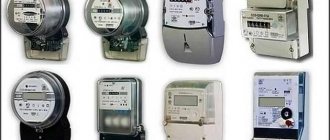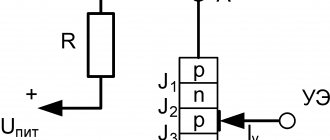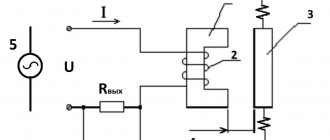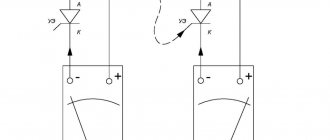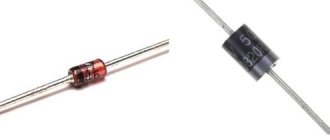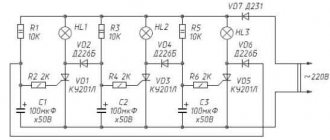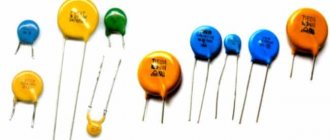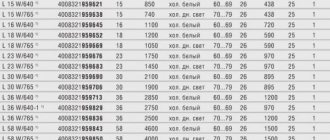Classification of devices
A voltmeter is a device that is used in electrical engineering along with an ammeter or ohmmeter. The device can be connected directly to a power source or in parallel with the load. Just by the name of the device, even a novice home DIYer can tell exactly what a voltmeter is needed for. A multi-stage system is used to classify these devices.
According to purpose
If the meter body is marked B2, then it is intended for use in DC electrical circuits. There are also devices for measuring alternating voltage, designated B3.
Types of voltmeters according to purpose:
- Phase. Designed to determine the indicators of the quadrature components of the fundamental harmonic of electric current and are marked - B5.
- Universal - marking B7. Allows you to take readings in any electrical circuits. Many models are equipped with a set of shunts to ensure a safe connection.
- Pulse - B4. These meters are widely used due to their functionality. With their help, you can detect impulse noise in the electrical network.
- Selective frequency search meters. These devices have the largest dimensions and allow processing complex signals, isolating harmonic elements from them. They can often look like radios.
All these types of voltmeters are widely used in everyday life or industry.
By external signs
Voltage meters can be divided into three large groups. Among them, stationary ones have the largest dimensions.
They are designed for continuous monitoring of electrical network performance. This may be necessary to maintain the smooth operation of various equipment. These devices are characterized by high sensitivity and measurement accuracy.
Devices that are mounted in electrical cabinets are called panel devices. Compared to stationary ones, they are smaller in size. Portable (autonomous) meters, due to their light weight and dimensions, are extremely convenient to transport, so they are widely used in everyday life. These meters are also equipped with probes for quick readings.
Range and method of measurement
You don't have to be a professional electrician to know what voltage is measured in. The basic unit is Volt (V). However, in electrical circuits the voltage can be different.
All voltage meters can be divided into several groups according to the range of measured values:
- microvoltmeters - allow you to measure millionths of a volt;
- millivoltmeters - capable of recording thousandths of a voltage unit;
- kilovoltmeters - designed to determine high voltage, measured in kV.
Meters can be electromechanical (pointer), as well as electronic (digital). Devices of the first type are equipped with a digital scale and a pointer mounted on a frame with a winding. They have a certain sensitivity. This is the coefficient of dependence between the actual electrical voltage in the circuit and the angle of rotation of the arrow.
The device of an electronic type voltmeter requires a display to display the readings taken.
In addition, the design includes a special microcircuit whose task is to convert the analog signal to a digital one. These meters are highly sensitive and reliable, so their cost is higher than their electromechanical counterparts.
Features of the scheme
The circuit of a digital voltmeter is based on discrete quantities. A simplified diagram includes the following elements:
- input device (ID);
- analog-to-digital converter (ADC);
- digital readout unit (DRB);
- control device (UD).
Interaction between the UE and the digital data center occurs through decimal numbers. In the case of determining AC voltage, the VU functions as a simple converting device, producing direct current. At this moment, the DSB is working on an analog signal, which is represented by a digital code.
Converting current from one type to another is also typical for devices such as multimeters. Some modern models of voltmeters use a binary code system, which greatly simplifies the process of receiving a signal.
Principle of operation
Electromechanical type meters were the first to be created. They operate using the magnetoelectric principle. A permanent magnet is fixedly fixed, and a steel core is installed between its poles. This structural element is installed in such a way that a constant electromagnetic field can be formed in the annular air gap.
A frame made of aluminum is installed in the gap on the axle shafts. She is able to move freely. There is also a spool of thin wire on the frame. The indicator arrow of the device is attached to the frame using springs. As soon as an electric current begins to pass through the device, an electromagnetic field appears in the winding. The frame interacts with it and deflects along with the arrow to a distance corresponding to the voltage value.
The design of the meter also contains an induction damper - an aluminum plate mounted on a frame with an arrow. In accordance with Lenz's rule, eddy currents arising in the damper interact with the magnetic field that generated them and slow down the oscillations of the device pointer. To achieve the required measurement accuracy, the device must not be exposed to gravity during operation.
To solve this problem, the moving part of the meter is equipped with a system of weights moving on rods. In addition, to ensure accurate measurements, it is necessary to reduce the friction force of the steel tips . This is achieved through the use of special wear-resistant steels. Parts made from them are polished.
Before starting the measurement, the user needs to set the indicator arrow to the zero position.
For this purpose, the design of the device includes a special adjustment screw connected to a spring. This is a classic design, but today there are devices containing magnets of different shapes. Moreover, in some designs the magnet is movable.
Main characteristics
The higher the internal resistance of the device, the less influence it has on the operation of the measured electrical circuit. Meters with high output impedance are more accurate. When choosing a voltmeter, you need to pay attention to its characteristics. Among them, the most important are the following:
- measurement range;
- internal resistance;
- AC frequency range;
- measurement error.
The measuring range of the device is selected depending on what quantities you plan to work with. Most models are capable of measuring voltage from several tens of millivolts to hundreds of kilovolts. Accuracy is also an important characteristic.
This indicator is determined by the manufacturer using special tests. You can get acquainted with the characteristics of the device in its operating instructions.
Connection methods and features of digital voltmeters
It is customary to distinguish two options for connecting the device:
- Parallel. The voltmeter is connected in parallel to the electrical circuit.
- Direct connection of the voltmeter to a source of electrical energy.
The main features of digital devices are convenient operation and high accuracy of readings. The last parameter is due to the high level of internal resistance.
Terms of use
The device must be connected to the circuit in parallel. You should make sure that it has the measurement range that is intended. Other rules for proper operation include:
- polarity must be observed;
- to measure the voltage at the power source, the device is connected directly to its terminals;
- It is not allowed to check high-voltage sections of the circuit with voltmeters that are not designed for high voltage;
- When using a universal meter, you must first select the desired operating mode.
When choosing a device, users should focus on their own budget and assigned tasks. In order for the purchased device to serve for many years, all operating rules must be followed.
